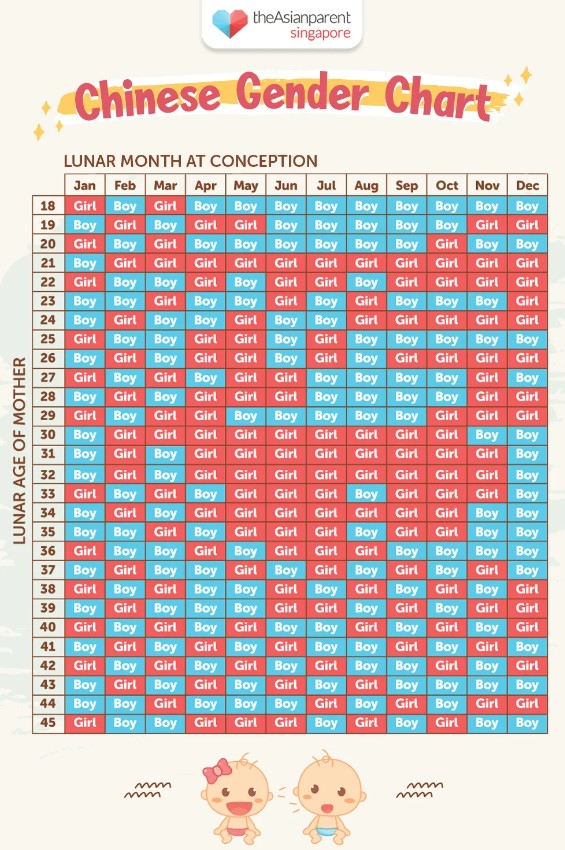Boy or girl? 'Predict' your baby's gender with this Chinese pregnancy calendar


Congratulations, you’re pregnant! So what’s next? As your baby grows in your tummy, you probably can’t help but wonder if your baby is a girl or a boy.
While you will eventually know your baby’s gender such as by taking an ultrasound during your second trimester or in some cases, genetic testing, it can be enticing to get a confirmation in advance.
To feed your curiosity, you might have even taken to ways such as examining your morning sickness, pregnancy cravings (girl if you crave sweets, boy if cravings are salty and sour), to even the position of baby bump (high bump for girls, low for boys). The list goes on.
But as far as some, if not many parents simply try these methods for fun, there’s another popular method which some parents believe to be more credible: the Chinese Gender Predictor or Chinese Pregnancy Calendar.
This origin of this simple test basically dates back to some 700 years ago where legend says that a gender prediction calendar was discovered by a scientist in a royal Chinese tomb in Beijing, China.
But apparently, that is just one version to its origins. Either way, experts have yet to find any conclusive scientific evidence to back its credibility.
Supporters of the Chinese gender predictor chart, however, say that it presents an accuracy of up to 90 per cent of the time.
Still, with just two outcomes (either girl or boy), the success of determining the correct gender of baby is statistically only a 50 per cent chance every time — just like flipping a coin.
In addition, not all charts appear the same and often provide a different gender prediction, which certainly leaves room for doubt.
While there’s no harm in using it, parents are advised not to make any important decisions following the reveal of their results (read: hastily buying items of a certain gender, among others).
If you would like to get a prediction in the name of fun, go ahead and refer to the table below.
In the Chinese gender prediction chart, two important details are needed: the mum-to-be’s birth date and date of conception (or the baby’s estimated due date in some versions).
What the Chinese Gender Predictor Chart does is convert what you have input into the calendar to your lunar age when you got pregnant and the lunar date of conception. In a matter of seconds, you find out if your baby is a girl or boy.
Otherwise, simply refer to this chart if you would like to seek a quick and fuss-free prediction.
To read the chart, firstly locate the age of when you conceived and then connect it to the month when your baby was conceived.

As mentioned, there is no surefire way to determine your baby’s gender other than through your obstetrician or gynaecologist.
While these methods often take some time to reveal your baby’s gender, they are known to be highly accurate.

As to how long it will take, it varies on the type of test you take. In most cases, it will be an ultrasound that you will undergo between 18 and 20 weeks.
The key lies in identifying the baby’s genitals. The ultrasonographer will look at your baby’s image on the screen and examine the genitals for different markers that suggest a boy or a girl.
Still, the results are not 100 per cent accurate—at least until your baby’s genital anatomy is developed enough, and considering that there is no human error in identification.
In the event where the baby refuses to cooperate and isn’t in an ideal position, you might have to wait it out or take a repeat scan.

Another way to get to know your baby’s gender earlier is through a blood test. You can take it as early as nine weeks into your pregnancy.
All you need is to provide a blood sample which will be sent for testing. You can receive your results in a matter of days.
While doing a blood test can help to reveal the gender of baby, it is more importantly used to test for Down syndrome and other genetically inherited conditions.
Like the free cell DNA tests, genetic testing like amniocentesis or chorionic villi sampling (CVS) can tell you your baby’s sex but just not as early.
While these procedures are 100 per cent accurate in determining baby’s gender, they are more invasive as they are designed to detect chromosomal abnormalities.
That said if your purpose is only on how to predict baby gender, it is recommended to skip these tests as they come with certain risks to miscarriage.
They are generally reserved for high-risk pregnancies: older women or couples with a family history of certain genetic conditions.
This article was first published in theAsianparent.